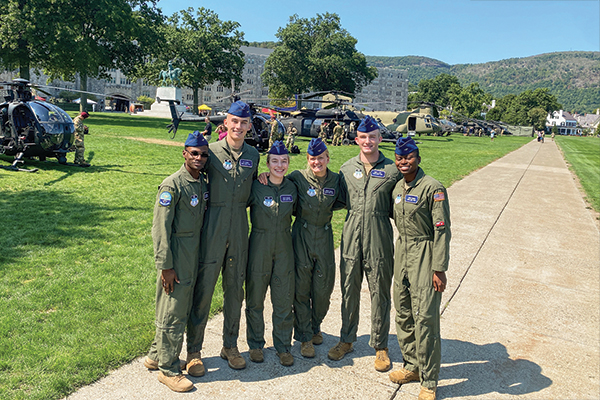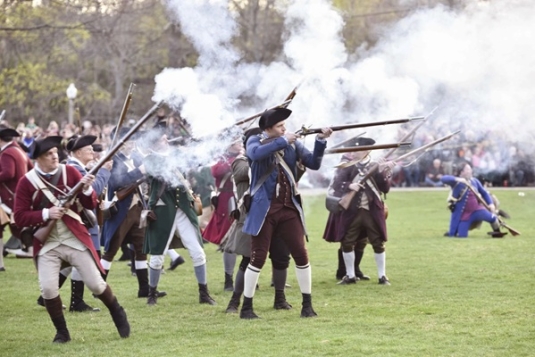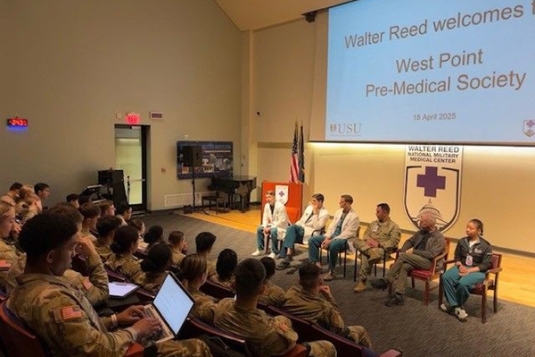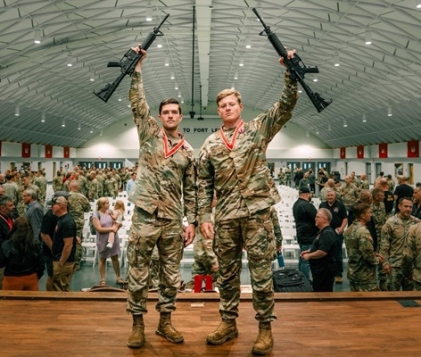By Keith J. Hamel, WPAOG staff
Prior to every fall semester, on the Sunday before Reorganization Week in August, West Point brings 19 “outsiders” to Post—seven Air Force Academy cadets, seven Naval Academy midshipmen, and five Coast Guard Academy cadets—as part of the Service Academy Exchange Program (SAEP).
Correlatively, the same number of USCC Second Class cadets leave West Point in the one-for-one swap between the academies to spend their fall semester in either Annapolis, Maryland; Colorado Springs, Colorado; or New London, Connecticut. SAEP was established through a memorandum of agreement between the commandants of each service academy in order “to promote the exchange of professional, academic, and social experiences.” It evolved from a weekend exchange program that started between USMA and USNA in 1945. Today, the spirit of cadet‐midshipman camaraderie gained through close personal experiences contributes greatly to good relations between the academies and, as a result, the four services. What follows is an assessment of how SAEP cadets view West Point, based on interviews with cadets and midshipmen who participated in the program during the 2022 fall semester.
“I chose USMA because I am pre-med, and there is extensive overlap in the medical field between Army and Air Force. I also chose USMA because my brother is currently a West Point cadet and my parents are ’98 grads.”
— USAFA CDT Emily Hofmann
SAEP cadets want to come to West Point for a number of reasons. Most, like Midshipman Sarah Hopkins, make USMA their first choice because they want to understand the ways in which West Point prepares cadets to lead in the U.S. Army. Others, like USAFA Cadet Emily Hofmann have personal reasons for applying to USMA. “I chose USMA because I am pre-med, and there is extensive overlap in the medical field between Army and Air Force,” says Hofmann. “I also chose USMA because my brother is currently a West Point cadet and my parents are ’98 grads.”
While some SAEP cadets have a personal connection to West Point (“Both of my parents, one a USAFA grad and the other a USNA grad, actually met as SAEP cadets at USMA in 1997,” says Midshipman Josh Dickson), many did not know much about West Point before arriving, besides a couple of its historical factors and notable graduates.
“I knew little of USMA prior to SAEP,” says USCGA Cadet Mackensi Rollings, “but I reached out to prior exchangers to get a better understanding of what West Point would be like.”
Of course, relying on those external to the Academy to describe West Point could potentially reveal bias. When asked, “How do those at your home academy ultimately view or think about West Point?” a couple of the answers from SAEP participants were startling (even if just in jest): “The Naval Academy views West Point as those people from the ‘Great Up North’ who live in a perpetually gray world and spend a decent amount of time in the dirt eating bugs”; or “Most Air Force cadets see West Point as the academy you go to if you didn’t get accepted to USAFA.” Yet most SAEPers acknowledge that a semester at West Point erased any stereotypes they might have had about USMA. “The common Naval Academy viewpoint is that West Point has a lower quality of life compared to Annapolis,” says Hopkins. “I found this point of view to be a broad generalization that isn’t completely accurate.” USAFA Cadet Wyatt Hodson reached a similar conclusion. “I think many people use stereotypes of the overall services and apply them to the academies,” he says. “Upon discussing it with the SAEP midshipmen and knowing the ins and outs of our day-to-day experience at USAFA, I’m confident that everyone who participated in SAEP could succeed at USMA just as every cadet at USMA could succeed at another service academy.”
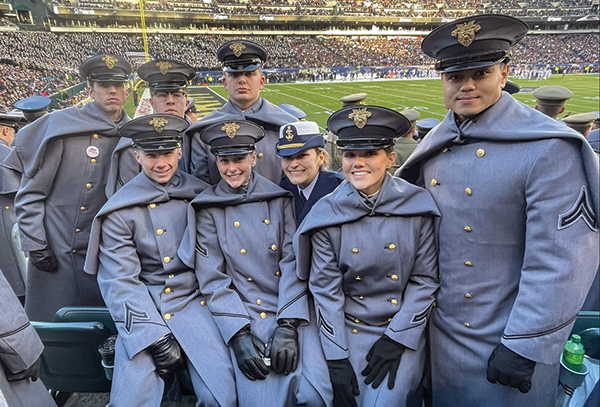
Life at West Point for those in SAEP is like that of any USMA cadet. Per the SAEP memorandum of agreement, they are expected to participate in all aspects of USCC cadet life while at USMA. Once they are in-processed on that Sunday in August, they become fully immersed as a USMA cadet, bound to USCC regulations (“I did more drill in one semester than I have my entire time at USAFA,” says Hofmann) and afforded the same privileges as well (“I joined the Army Climbing Team and the Bowling Team while at USMA, providing me an opportunity to branch out and try new activities that I don’t do at USNA,” says Hopkins).
“Academically, I worked with the Combating Terrorism Center, Modern War Institute, and International Affairs Program,” notes Rollings. “Militarily, I was involved with USMA’s Affinity Councils, specifically the Corbin Forum, and athletically I participated in company intramurals with my fellow F-3 Troopers (‘Mount Up!’).” All SAEP cadets served as squad leaders for their USCC company, a few competed on a USMA competitive club team (USAFA Cadet Ruben Banks made the Fencing Team and USAFA Cadet Zharia Wilson made the Women’s Boxing Team), and one SAEPer “tabbed” the IOCT (“probably one of the proudest moments of my life,” she says).
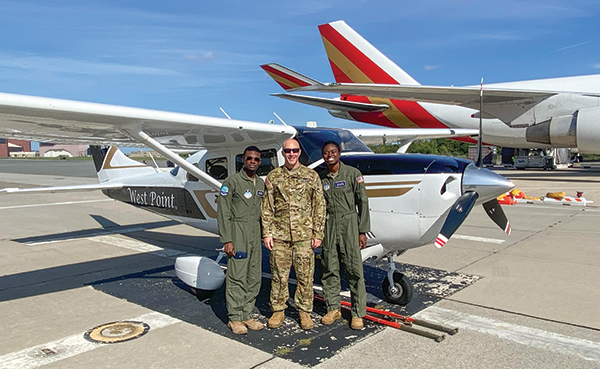
Full participation also means partaking in West Point traditions during SAEP. “I was a fan of the Thursday night spirit dinners,” says Banks. Hofmann says, “I really enjoyed Christmas dinner and singing the ‘12 Days of Christmas.’” “My favorite moment at West Point had to be the trip to New York City for the ‘Tunnel to Towers’ run,” says Hodson. “It was my first time in NYC, and running from Brooklyn to Manhattan was the most patriotic I have ever felt in my life.” Hodson also notes that the Air Force-Navy Game can’t compete with the Army-Navy Game. “I will never forget storming Lincoln Financial Field in Philadelphia with my I-3 companymates screaming for our lives after a double-overtime Army victory,” he says. “Although it pains me to say it, the atmosphere and the energy of the Army-Navy Game is indescribable and clearly surpasses our game against Navy.”
As the above anecdote suggests, SAEPers often compare their West Point experience to life at their home academy. Sometimes, they are forced to do so. “I’m still being asked to this day by those in my squadron which academy has the better food,” says Banks. “I normally respond by saying that food options are about the same; however, USMA provides a lot more variety.” Wilson is more candid: “The food was so much better at West Point,” she says. “USAFA should be ashamed of what they try to feed cadets on a daily basis.” And Hofmann unashamedly states, “The food at USMA was amazing!”
USMA cadets also pepper their SAEP peers for comparisons. “Everyone wanted to talk to the person in the different uniform to learn how things are different in Colorado Springs,” says Hodson. “From a social standpoint, my semester exchange has to be my favorite semester.” Midshipman Dickson says that being at West Point and wearing a different uniform was a cross between being an animal in a zoo and being a celebrity. “Random cadets would frequently yell ‘Beat Navy’ at me as I walked to class or through North Area,” he says, “but I found USMA cadets to be incredibly kind, genuine people who had goals and aspirations similar to mine and my friends at the Naval Academy.”
“Upon discussing it with the SAEP midshipmen and knowing the ins and outs of our day-to-day experience at USAFA, I’m confident that everyone who participated in SAEP could succeed at USMA just as every cadet at USMA could succeed at another service academy.”
— USAFA CDT Wyatt Hodson
So, what are the biggest differences between the academies? Air Force cadets tend to see West Point as academically easier but militarily harder than their home academy. “When they ask me about my USMA experience, I often tell those in my squadron that West Point focuses more on the military than academics, which makes your courseload easier in exchange for less freedom,” says Wilson. “But while USMA was a lot more restrictive and disciplinary, I found that West Point cadets complain less than USAFA cadets do.” Regarding discipline, Hofmann, Wilson’s classmate, says, “USMA is quicker to give punishments and allows cadets only a small margin for error, while USAFA reserves strict punishments for large infractions.”
Interestingly, the midshipmen found academics harder at West Point. “The dreaded Thayer Method is worth dreading because it makes everything harder,” says Dickson, “but it helped me to become better at studying, and academically I learned a lot during my semester exchange.” Furthermore, Hopkins found USMA’s “study days” to be one of the smartest and most useful tools implemented at West Point. “Due in large part to the usefulness of study days, I was able to go from being ‘UNSAT’ at the six-week grading period to having my highest QPR yet.” Midshipmen found that the biggest difference between West Point and Annapolis had to do with “workout cultures.” “West Point values size and strength over pure speed,” says Dickson. “Cadet culture at West Point embraces heavy lifting and less running, while at the Naval Academy there’s plenty of nice weather and flat land, which gives mids plenty of opportunities to spend their time running or doing calisthenics.” Hopkins sees the differences in the physical mission and workout culture between USMA and USNA as stemming from the Army Combat Fitness Test and West Point’s IOCT graduation requirement. “Witnessing and trying both of these physical events was a cool experience,” she says, “especially since both are completely different from the physical events administered at the Naval Academy.”
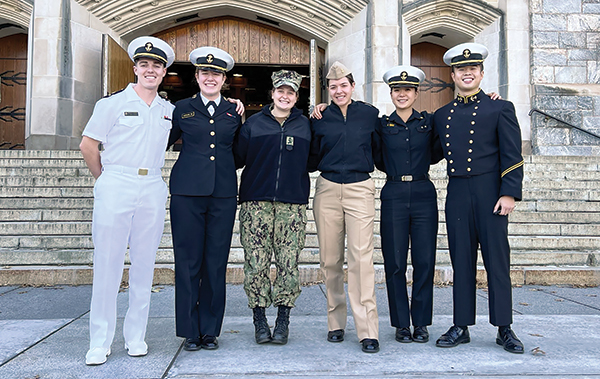
While most SAEPers acknowledged a variety of differences between the academies—“The tradition of espirit de corps is stronger at West Point,” says Rollings; “‘Outside-the-gate’ life is a lot better at USAFA,” says Wilson—all agreed that there are more similarities than differences and that there is a great deal of mutual respect for all who make the decision to serve their country as a future military officer. An exchange between Lieutenant General Steven Gilland ’90, USMA Superintendent, and USAFA Cadet Wyatt Hodson reiterates this point:
“All the SAEP cadets and midshipmen were at the Commandant’s house for an ice cream social a few weeks after our arrival,” Hodson says. “General Gilland was there, and we were in a circle talking about the differences we had noticed so far. I mentioned that my walk across campus at West Point was a lot shorter than it is in Colorado Springs since our school is in the mountains and so spread out. ‘Stop!’ said the Superintendent. ‘Never use the words ‘campus,’ ‘college,’ ‘school,’ etc.: You go to an academy, and all of you have earned the right every day to use that word.’ That made me realize just how proud I am to attend one of the service academies, because, truthfully, they’re all significantly more demanding than any college or university in America.”

